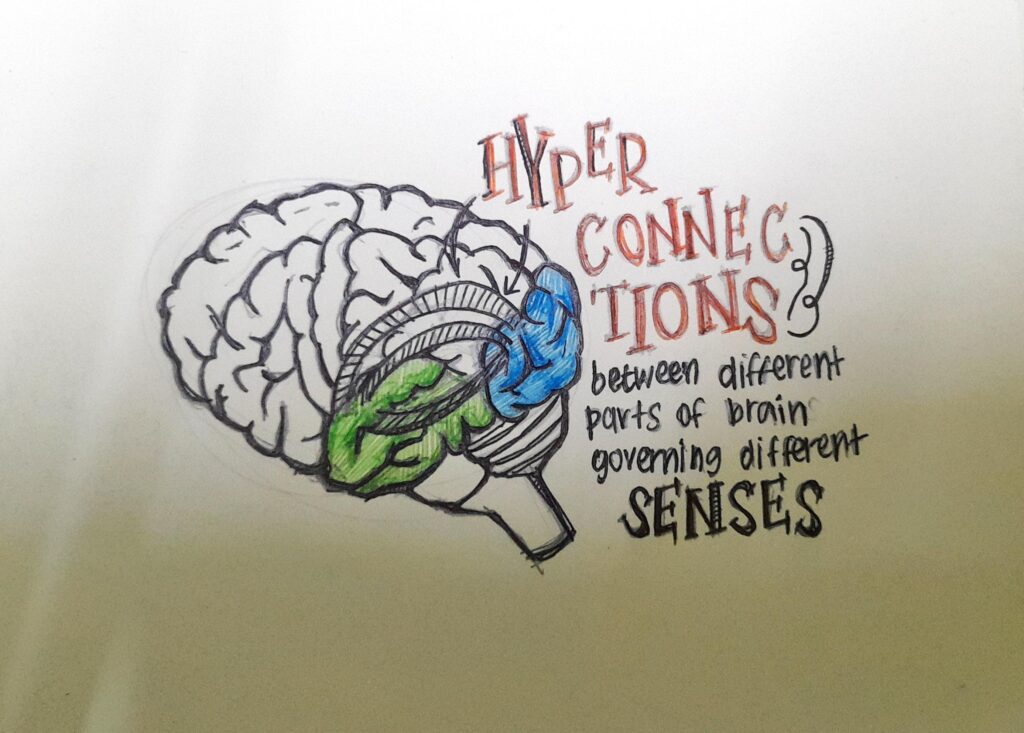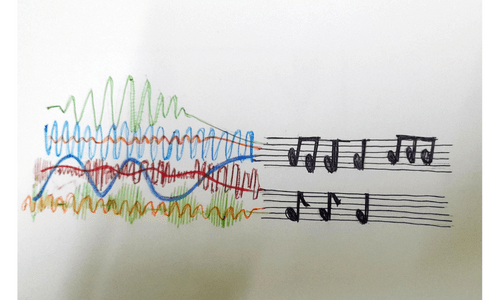Think of a world where you can taste words. Jail tastes like cold hard bacon or college tastes like sausage. A place where music is seen and colors are heard, where every note appears as a flash of hue before your eyes. Where words, numbers or letters invoke colors or even a personality. Hate the number nine? Why not? It looks like a vain elitist girl to you. These realms that I describe may seem fictional to us but they are a reality to almost 4% of the world’s population through a condition that is called synesthesia.
Synesthesia simply means ‘Joint sensation’. It’s a neurological phenomenon where our senses combine, where one of our senses involuntarily triggers a response in the other. What does this mean? Think of the realms described above. Seeing music combines our senses of hearing and sight, whereas tasting words is a combination of hearing and taste. Similarly the many senses of the human body can be paired together to give rise to several combinations, of which 60 forms of synesthesia have been documented till today.
All our senses are linked to each other via the brain, thus it seems obvious that the answer to why synesthesia exists lies somewhere deep within our neurons and the connections between them. Scientists have proposed that synesthesia may result from having excess neural connections or hyper connections between the different parts of the brain that govern the different senses. Think of our brain like a railway network, where different stations are parts of the brain that are linked to our senses. Thus a synesthete ( a person with synesthesia) has more railway tracks between the auditory and visual stations of the brain than a non-synesthete, thereby leading to more connectivity. This increased connectivity is what allows the visual part of the brain to be activated when the auditory part is activated, i.e. when something is heard, you see colors or shapes, thereby leading to synesthesia. One of the possible reasons for such increased neural connections could be decreased neural pruning. Our brains are made up of neurons i.e. the nerve cells. These nerve cells are linked to each other via synapses, which allow neurons to communicate and pass on information. Neural pruning is selective elimination of these synapses, meaning that this process severs the link between neurons. This breakage allows separation between different parts of the brain, i.e. it results in less train tracks between stations. In synesthetes, this separation doesn’t occur since neural pruning is decreased, thereby allowing the neurons between the two areas or stations to still remain linked. This is why if someone has synesthesia of a certain kind, there’s a 50% chance that they may have another form of the same, since the decrease in neural pruning could increase the connections between any two or more senses in our brains.

Another interesting fact about synesthesia is that it can be inherited. If you are a part of the 4% of the population, there’s a good chance that one of your relatives (hopefully someone you like) has synesthesia as well. However, the type of synesthesia you two possess could be different. In fact people with the same type of synesthesia may not necessarily experience it in the same way. If one person sees green for a certain sound, the other could see blue or any other color. Since synesthesia is inheritable, there’s an obvious genetic component to the condition. The gene or genes responsible for it and how those genes are transmitted to the next generation still remain mysteries.
Synesthesia is a trait as mentioned before and not a disorder like most people presume. In fact, synesthetes have better memories. Our brains are great jesters, and love to embarrass us by forgetting the name of a person mere seconds after they have told us. Imagine if you had synesthesia, and you run into someone you met a few days ago, and yet you can’t remember her name. You know her name is red. Red is the color of ‘S’. Sakshi? Snehal? Sujala? Shruti? Yes! Her name is Shruti, you remember, saving you from the humiliation of having to ask again.
The idea of combining our senses may seem like a blessing, but some forms of this phenomena might be harder to deal with. One such example is mirror-touch synesthesia. People with the condition experience tactile sensations through sight. This means that when they see someone else being touched, they feel the touch themselves. If someone touches their right arm, such synesthetes experience a sensation on their left, hence the name ‘Mirror-touch’. Mirror-touch synesthetes can also feel the pain and emotions experienced by another person. A very interesting case of the condition is of Joel Salinas who himself is a doctor, probably the best in the world, since he can literally feel his patient’s pain. Imagine feeling everything you see on a daily basis. Overwhelming isn’t it?
Synesthesia itself is an unanswered question, but it could hold the key to many answers. Studying synesthesia may help us understand the inner workings of the brain, how we learn, how we perceive the world, and how we feel empathy and pain. Synesthesia is a wondrous phenomenon which makes us realize how different our bodies are from each other, and how each of us perceives the world in our own way.
To truly experience what a synesthete feels, check out this video!
Seeing song through the ears of a synesthete
REFERENCES:
2. https://www.ncbi.nlm.nih.gov/pmc/articles/PMC3222625/
4. https://www.youtube.com/watch?v=rkRbebvoYqI
. . .
Writer
Jwalanthi Sundaram
Illustrator
Anushree Joshi
Editor
Eesha Gupte

